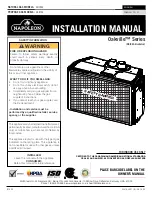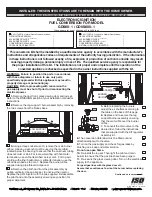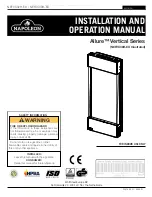
E
447 B – 447 C – 447 M – 447 CM – 447 IP65
PRODUCT OVERVIEW
The sensors 447 have been designed using advanced CMOS technology, to offer a product that will out perform immunity to false alarm.
The detectors are truly solid state with no moving parts and are therefore non-gravity dependent – they can be installed in any plane or
orientation. Both models offer a latching Led indication that can be remotely reset of left illuminated to act as deterrent. Sensitivity is
controlled by a variable potentiometer coupled with a Dual Sensitivity link – so offering fine adjustment possibilities. For problematic
situations or sites that offer a high probabilità of single unintentional impacts a Patent Double Knock feature is offered.
INSTALLATION
•
Cable entry to the detector can be gained form the rear or via the cable knockouts in the lid.
•
Where possible the cable should run upwards to the detectors.
1.
Remove the detector form its packaging and retain the two mounting screws.
2.
Remove the lid by means of the screw. To remove printed circuit board (PCB) and assist the installation. Hold the PCB by the
outboard end of the terminal strip and rotate away from the base moulding.
3.
Select the desired location for the detector, ensuring the surface is smooth and clean.
4.
Attach the base using the 2 screws provided (longer screws can be used providing the diameter is not increased).
5.
The detector can now be wired to your installation requirements.
INSTALLATION 447 IP65
1. Remove the lid by means of the screws. To remove printed circuit board (PCB) and assist the installation. Hold the PCB by the
outboard end of the terminal strip and rotate away from the base moulding.
2. Select the desired location for the detector, ensuring the surface is smooth and clean.
3. Attach the base using 4 screws.
4. The detector can now be wired to your installation requirements.
CALIBRATION (Valid irrespective of installation wiring)
1.
Ensure the control panel is OFF or UNSET.
2.
Ensure both DIL switches ON.
3.
Apply power to terminals 5 (12VDC) and 6 (0VDC).
4.
Set the detector to maximum sensitivity (adjust the Sensitivity Control fully clockwise and remove the Dual Sensitivity Link).
5.
Tap the base moulding lightly to censure functionality. The Led will light and flash within 8 second period.
6.
Apply a suitable implement around the extremities of the area under protection. The Led will now extinguish for 8 seconds on
detection of a valid vibration.
7.
If desired, the sensitivity in the High range area may now be reduced by turning the potentiometer anti-clockwise and repeating the
above process. If the potentiometer will not offer a sensitivity that is enough the Dual Sensitivity Link should be fitted. This now
allows the potentiometer to ad just the sensitivity in the low range area.
8.
This process can be repeated until the desired sensitivity has been achieved.
CONNECTIONS
•
Terminals 1 and 2 form a normally closet circuit, which will open momentarily on an alarm condition or permanently on power
removed. THIS IS THE ALARM CIRCUIT and should be wired in series format.
•
Terminals 3 ad 4 form a normally closet circuit which will open whilst the cover is removed THIS IS THE 24 HOUR CIRCUIT and
should be wired in series format.
•
Terminals 5 and 6 are for the power input (from 9.5VDC to 15VDC).
•
Terminal 7 is the SET input, is used to remotely control the Led indication.
•
Terminal 8 is First to alarm Bus Line.
6 CORE WIRING (First to alarm and Remote Led control not available)
•
No wires are taken to terminals 7 (SET) and 8 (FTA).
•
If a Led indication is required DIL switch position 2 ON. (the led would be extinguished on power up and flash only on detection of an
alarm. It will remain flashing until an attack is detected when it will be extinguished for 8 seconds. To reset the Led completely the
power to the detector should be momentarily removed.
•
If no Led indication is required DIL switch position 2 OFF and a wire link fitted between terminals 7 (SET) and 5 (12VDC).
7 CORE WIRING (First to alarm not available)
•
No wire is taken to terminal 8 (FTA).
•
DIL switch position 2 OFF.
•
The wire to terminal 7 (SET) must be form a panel output which is 12VDC when the alarm is SET ( in an UNSET condition the
12VDC should fall to 0VDC)
•
The Led can now be controlled form the panel, there is no need to interrupt the supply to the detector. When the system is SET and
sensor activates the Led will be held OFF until the system is UNSET. The Led on any sensor triggered will then flash. The transition
to 12VDC on a subsequent setting of the system will reset the Led indications.
8 CORE WIRING
•
The wire which is taken to terminal 8 is common bus line which need not go back to the panel.
•
DIL switch position 2 OFF.
•
The wire taken to terminal 7 (SET) must be form a panel output which is 12VDC when the alarm is SET. In an UNSET condition the
12VDC should fall to 0VDC.
•
The End line Resistor supplied needs to be fitted on ONE DETECTOR ONLY form terminal 8 (FTA) to terminal 5 (12VDC).
•
The Led indication now can be controlled from the panel, there is no need to interrupt the supply to the detector. When the system is
SET and sensor activates the Led will be held OFF until the system is UNSET. The Led on the first sensor triggered will flash,
additional sensor that have activated will illuminated a steady Led. The transition to 12VDC on a subsequent setting of the system
will reset the Led indications and FTA memory.
NOTES
Single Knock
•
DIL switch position 1 ON.
This option will command the detector to respond to the first occasion the per-set alarm threshold is exceed (Sensitivity setting).
Double Knock
•
DIL switch position 1 OFF.
This option will permit the detector to ignore the first transient shock signal (less than 200ms) which exceeds the per-set alarm threshold and
respond only to the second impact – within an 8 second timeframe. >>If however the first impact exceeds this 200ms duration the detector will
respond instantaneously – Double knock will be overridden.
TECHNICAL INFORMATION
Working Voltage range: 9.5 – 15 VDC – Current Consumption: 8mA (quiescent)
Warranty: 10 years – expire date detailed by glue dots on the PCB.
Should you require assistance on these or any other product we can be contacted on the number.
MENVIER CSA reserves the right to change, without prior notice, specification of these products
from that detailed.
Via A. Meucci 10
20094 Corsico (MI) - Italy
Tel. +39-024587911
Fax +39-0245879105
E-mail: [email protected].
Internet: www.menviercsa.com
SENSITIVITY
CONTROL
PICK-UP
TRANSDUCER
TAMPER
SWITCH
LED
CUSTOM CHIP
DUAL SENSITIVITY LINK
1 2
DIL
SWITCH
PCB LAYOUT
8 7 6 5 4 3 2 1
Installation valid only for
C models (with
contact)
:
when installed correctly the unit will
activate on detection of
-
A valid vibration
-
The opening pf protected door /
window.
Install sensor in the normal manner,
generally on the frame of the opening to
be protected.
An allowance must be made for the
location of the magnet enclosure – this
must be within 8mm of the sensor on the
side as shown in the drawing. The face of
magnet enclosure must lie near as soon
as possible to the same level as the face
of the sensor – this can be varied by
adding the supplied spare bases.
Led doesn’t signal door opening, but only
a vibration.
NOTE One of the three bases has
a nut incorporated, this base
must be the one that the screw
from the cover passes into.
8mm MAX
MAGNET
REED
SWITCH
MAGNET
ENCLOSURE
BASE
WITH
NUT
DOOR
FRAME
RIF. 08898 REV. 01
447 IP65




















